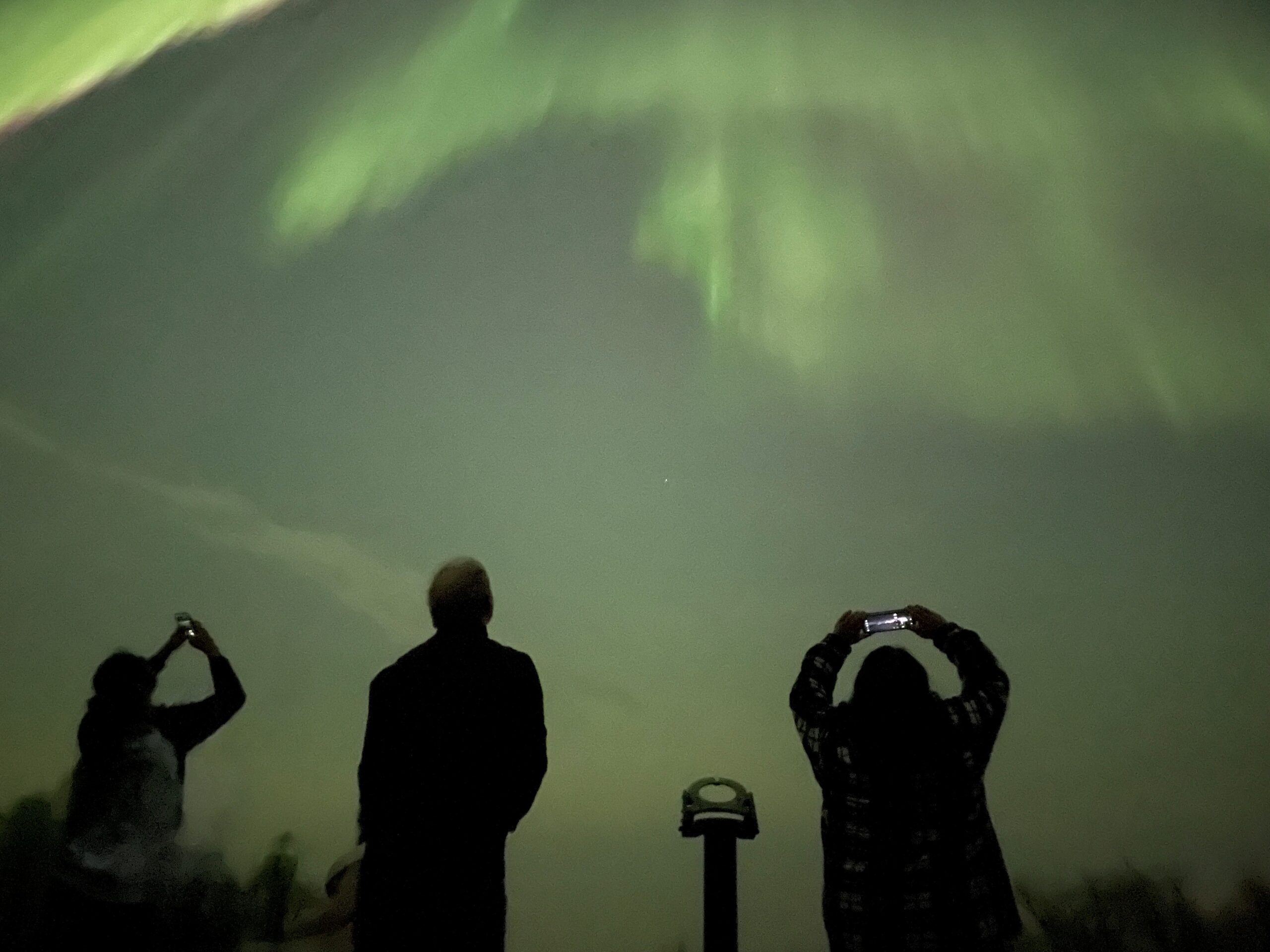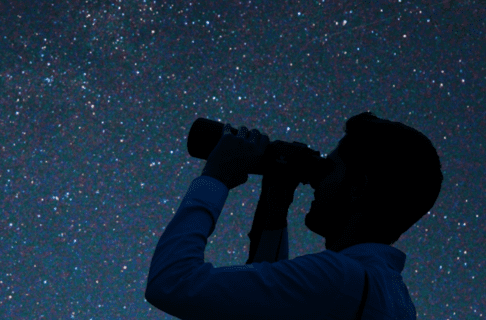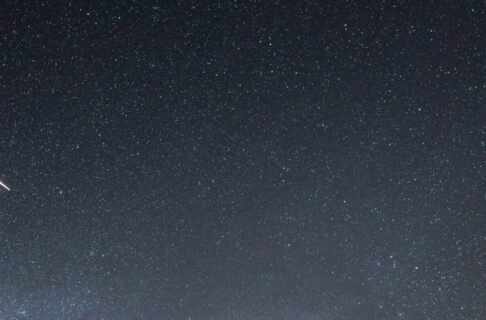July skies bring a return to darkness as the sun begins to set earlier each night. It also signals various summer activities and holidays for many. It’s during summer vacation that many people can most easily get away from the city into a darker sky, whether it is during a camping trip, visit to a cabin, or just a drive out of town. Even from a bright city, though, you can spot several interesting sights in the July sky.
The Solar System for July 2025
Mercury technically remains visible for the first week of July, but it will be a challenging observation. The planet is very low in the western sky 30 minutes after sunset, when the sky is still bright, and it sets soon thereafter. A pair of binoculars and a very clear western horizon without buildings or trees will be necessary to catch Mercury this month.
Venus is low in the eastern sky just before dawn. It rises about 3am this month, slowly climbing higher each morning before the sunrise. See also Jupiter, below.
Mars is in the constellation Leo, fading into the sunset twilight over the course of the month. The waxing crescent Moon is to the left of Mars on the evening of July 28th.
Jupiter rises up out of the morning twilight to greet Venus this month. Jupiter begins the month too low to see before sunrise, but rapidly rises higher to stand to Venus’ lower level by the third week of the month. The waning crescent Moon passes Venus and Jupiter on the mornings of July 21-23.
Saturn rises about midnight, the brightest object in an area of sky devoid of brighter stars. By 4 a.m. local time it is 30 degrees up in the southeastern sky. Saturn’s rings are tilted almost edge-on to our line of sight, making them difficult to see in a telescope. Neptune is nearby for most of the summer (see below). The waning gibbous Moon is nearby on the night of July 15-16.
Uranus is in the morning sky a few degrees below the famous Pleaides star cluster (also known as the Seven Sisters). It is too faint to easily see without binoculars, and even a telescope shows it as a faint dot that looks just like the other faint stars. A starcharting app like Stellarium is required to track it down.
Neptune is in the same binocular field of view as Saturn for the entire month, but sicne it is even farther than Uranus it is invisible without optical aid. Neptune requires good binoculars or a small telescope to even spot, and a large telescope to make it out as anything more than a faint dot.
Of the five known dwarf planets, only (1) Ceres is close enough to be seen in binoculars or a small telescope. In June, Ceres in below and to the left of Saturn and Neptune; you’ll need a chart like the one in the RASC Observer’s Handbook or an app like Stellarium to track it down. Ceres will be easier to spot in the fall as it gets closer and brighter.
Sky Calendar for July 2025
All times are given in the local time for Manitoba: Central Daylight Time (UTC-5). However, most of these events are visible across Canada at the same local time without adjusting for time zones.
If there’s a little box to the left of the date, you can click on it to see a star map of that event!
![]() Tuesday, July 1, 2025 (evening): Mercury is at its best for the month (see entry in Solar System above), while Mars and the bright star Regulus are farther to the southwest.
Tuesday, July 1, 2025 (evening): Mercury is at its best for the month (see entry in Solar System above), while Mars and the bright star Regulus are farther to the southwest.
Wednesday, July 2, 2025: First Quarter Moon
Thursday, July 10, 2025: Full Moon
Friday, July 11, 2025 (evening sky): Technically, the nearly-Full Moon eclipses Pluto this evening, but the event is totally unobservable because Pluto is so faint and the Moon is so bright. However, it’s likely this will be blown out of proportion on social media because everyone likes the Moon and Pluto.
Wednesday, July 16, 2025: The waning gibbous Moon is above Saturn tonight and into the early hours of tomorrow.
Thursday, July 17, 2025: Last Quarter Moon
![]() Sunday, July 20, 2025 (morning): The Moon passes through the Pleaides star cluster beginning about 3:45 a.m. CDT, slowly occulting (eclipsing) each star in turn. This event will be visible in binoculars or a small telescope, and vividly demonstrates the Moon’s orbital motion around the Earth.
Sunday, July 20, 2025 (morning): The Moon passes through the Pleaides star cluster beginning about 3:45 a.m. CDT, slowly occulting (eclipsing) each star in turn. This event will be visible in binoculars or a small telescope, and vividly demonstrates the Moon’s orbital motion around the Earth.
![]() Monday, July 21, 2025 (morning): The waning crescent Moon stands high above Venus in the east-northeast before sunrise.
Monday, July 21, 2025 (morning): The waning crescent Moon stands high above Venus in the east-northeast before sunrise.
![]() Tuesday, July 22, 2025 (morning): The waning crescent Moon forms a wide triangle with Venus (to its left) and Jupiter (to its bottom right) in the northeast this morning before sunrise.
Tuesday, July 22, 2025 (morning): The waning crescent Moon forms a wide triangle with Venus (to its left) and Jupiter (to its bottom right) in the northeast this morning before sunrise.
![]() Wednesday, July 23, 2025 (morning): The waning crescent Moon is to the left of Jupiter in the pre-dawn sky, low in the north-northeast.
Wednesday, July 23, 2025 (morning): The waning crescent Moon is to the left of Jupiter in the pre-dawn sky, low in the north-northeast.
Thursday, July 24, 2025: New Moon
Friday, July 25, 2025: The dwarf planet Pluto reaches opposition, the time when it is brightest and closest to Earth. For Pluto, though, “brightest” is relative: it’s still invisible without a large telescope.
Tuesday, July 29, 2025 (morning sky): The annual South Delta Aquariid meteor shower peaks this morning before dawn. This is not a very good shower, only producing 10 or so meteors per hour. At least it happens near New Moon, so there won’t be any moonlight to hide the few meteors that do occur.

Outside of the regular events listed above, there are other things we see in the sky that can’t always be predicted in advance.
Aurora borealis, the northern lights, are becoming a more common sight again as the Sun goes through the maximum of its 11-year cycle of activity. Particles from the Sun interact with the Earth’s magnetic field and the high upper atmosphere to create glowing curtains of light around the north (and south) magnetic poles of the planet. Manitoba is well-positioned relative to the north magnetic pole to see these displays often, but they still can’t be forecast very far in advance. A site like Space Weather can provide updates on solar activity and aurora forecasts for the next 48 hours. The best way to see the aurora is to spend a lot of time out under the stars, so that you are there when they occur.,
Random meteors (also known as falling or shooting stars) occur every clear night at the rate of about 5-10 per hour. Most people don’t see them because of light pollution from cities, or because they don’t watch the sky uninterrupted for an hour straight. They happen so quickly that a single glance down at your phone or exposure to light can make you miss one.
Satellites are becoming extremely common sights in the hours after sunset and before dawn. Appearing as a moving star that takes a few minutes to cross the sky, they appear seemingly out of nowhere. These range from the International Space Station and Chinese space station Tianhe, which have people living on them full-time, to remote sensing and spy satellites, to burnt-out rocket parts and dead satellites. These can be predicted in advance (or identified after the fact) using a site like Heavens Above by selecting your location.






